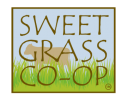FAQ’S
Lorem ipsum dolor sit amet, consectetur adipiscing elit. Ut elit tellus, luctus nec ullamcorper mattis, pulvinar dapibus leo.
- How is Sweet Grass beef different than other grass-fed beef?
The USDA retracted their grass-fed label and therefore there are no strict guidelines for beef labeled as “grass-fed.” Some “grass-fed” cattle are fed alfalfa cubes in a feedlot. Sweet Grass cattle are never confined and never fed anything other than grass or forage. Sweet Grass ranchers truly care about the welfare of their animals.
Sweet Grass cattle are raised as partners in the fight to restore soil health. They are rotationally grazed and managed to help put carbon from the air, as CO2, back into the soil. This helps to mitigate greenhouse gases, puts nutrients back into the soil, decreases the risk of drought and flooding among other benefits.
Sweet Grass Cooperative ranchers buy hay from local farmers, lease ground from local farmers and landowners, employ local help, utilize and support local butchers- all putting money back into our community.
Sweet Grass cattle are treated with the utmost respect for the whole of their lives. They live their lives on grass and forage in the pasture, rotated to ensure they get the most of the grass and adequate nutrients. They are handled with low-stress handling techniques. This includes ranchers staying calm and working with the cattle and facilities being built with cattle’s natural instincts in mind.
“Fat is flavor.” Intramuscular fat contributes to flavor. While most grassfed beef is considered lean, there still needs to be an adequate amount of “finish” on an animal to ensure a favorable taste. This is very difficult to accomplish on a grassfed diet. However, Sweet Grass ranchers have been grass-finishing cattle since the very beginning and have a great deal of experience and pride when it comes to ensuring cattle are effectively finished before sending any meat to their customers.
All cattle are raised on grass, but most are finished on grain. Sweet Grass animals are only fed grass and forage for the entirety of their lives.
No. Since the USDA retracted the grass-fed label, there are no strict guidelines on “grass-fed.” Cattle can be raised in a feedlot and fed alfalfa pellets like many commercial grass-fed animals and be labeled as “grass-fed.” The only real way to know how your cattle are raised is to know your ranchers. We invite you to come see how Sweet Grass cattle are raised, visit our ranches. Sweet Grass cattle are on pasture for their whole lives.
Research has shown that true grassfed, grass finished beef is lower in total fat, saturated fat, cholesterol, and calories and higher in antioxidants and heart healthy omega-3 fatty acids.
Yes. Cattle are ruminants, meaning they have a four-chambered stomach. The main requirements for cattle are protein, energy, water, vitamins, and minerals. Grass and forage can fully sustain these requirements.
Raising cattle means the world to our ranchers. They care for their animals until the very last minute of their lives to ensure that they are treated with respect. Sweet Grass ranchers work with our local processors to ensure that they are humanely slaughtered otherwise the work and care that our ranchers have put in means nothings. They regularly make suggestions and offer input to keep facilities as up-to-date and humane as possible.
Most beef from the store is not from the United States. With the rejection of COOL (country of origin labeling), manufacturers are not obligated to identify where the beef came from. Unfortunately, even if it says “product of the USA” it is likely beef imported from another country in primal form and cut up here. The process of cutting the meat into smaller portions enables it to become a “product of the USA” even if it originated from Uruguay.

